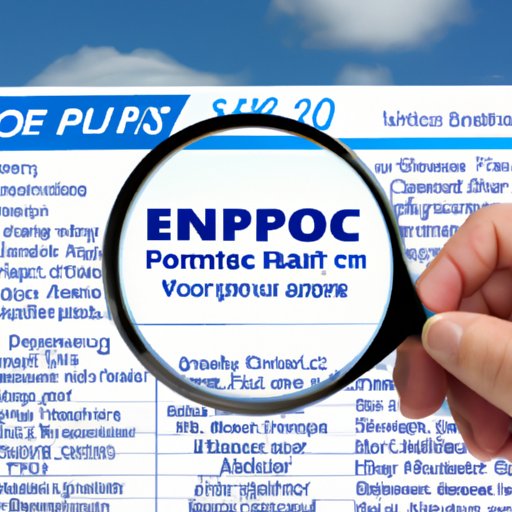Introduction
Health insurance can be a confusing topic for many people. With so many different types of plans available, it can be hard to know which one is right for you. One such type of health insurance is EPO, or Exclusive Provider Organization. Understanding what this type of plan is and how it works can help you decide if it’s the right choice for your health care needs.
Definition of EPO Health Insurance
An EPO, or Exclusive Provider Organization, is a type of health insurance plan that provides coverage only when you use doctors and hospitals that are part of the EPO network. It’s similar to a Preferred Provider Organization (PPO) plan in that it offers lower out-of-pocket costs when you use in-network providers. However, unlike PPOs, EPOs don’t usually allow you to go out of network and still receive coverage.
Overview of How It Works
EPO health insurance plans typically require you to choose a primary care physician who will coordinate all of your healthcare. Your primary care physician will be responsible for referring you to specialists and other providers who are part of the EPO network. This means that if you want to see a doctor who isn’t part of the EPO network, you won’t be covered for any of the costs associated with that visit.

Comparing and Contrasting EPO Health Insurance with Other Types of Insurance
It’s important to compare EPO health insurance with other types of insurance plans to determine which one is right for you. Here is a brief overview of how EPO health insurance differs from traditional health insurance, PPO plans, and HMOs:
Traditional Health Insurance
Traditional health insurance plans generally have a large network of providers and give you the flexibility to choose any provider you want. However, these plans often have higher premiums and deductibles than other types of plans. Additionally, traditional health insurance plans typically don’t cover services such as vision or dental care.
PPO Plans
PPO plans are similar to traditional health insurance plans in that they have a large network of providers and give you the flexibility to choose any provider you want. However, they also have the added benefit of lower out-of-pocket costs when you use in-network providers. Additionally, most PPO plans offer coverage for vision and dental care.
HMOs
HMOs, or Health Maintenance Organizations, are another type of health insurance plan. Unlike EPOs, HMOs require you to choose a primary care physician who will coordinate all of your healthcare. Additionally, you must use in-network providers in order to receive coverage. HMOs tend to have lower premiums and deductibles than other types of plans, but they also have more restrictions on the type of care you can receive.

Examining the Benefits and Drawbacks of EPO Health Insurance
When deciding whether or not to get an EPO health insurance plan, it’s important to consider both the benefits and drawbacks. Here are some of the advantages and disadvantages of EPO health insurance:
Advantages
One of the major advantages of EPO health insurance is that it has lower premiums and deductibles than other types of plans. Additionally, EPO plans typically offer more coverage for preventive care and prescription drugs than other types of plans. Finally, EPO plans often provide coverage for services such as vision and dental care.
Disadvantages
The biggest disadvantage of EPO health insurance is that you must use in-network providers in order to receive coverage. This means that if you need to see a specialist or receive care at a hospital that isn’t part of the EPO network, you won’t be covered for any of the costs associated with that visit. Additionally, EPO plans often have more restrictions on the type of care you can receive.
Analyzing Costs Associated with EPO Health Insurance
When considering an EPO health insurance plan, it’s important to understand the costs associated with it. Here is a brief overview of the costs associated with EPO health insurance plans:
Premiums
The premium is the amount you pay each month for your health insurance coverage. EPO health insurance plans typically have lower premiums than other types of plans.
Deductibles
The deductible is the amount you must pay before your insurance company starts covering your medical expenses. EPO health insurance plans typically have lower deductibles than other types of plans.
Out-of-Pocket Maximums
The out-of-pocket maximum is the maximum amount you must pay for covered services each year. EPO health insurance plans typically have lower out-of-pocket maximums than other types of plans.

Examining Different Companies That Offer EPO Health Insurance
There are a variety of companies that offer EPO health insurance plans. Here is a brief overview of some of the major providers as well as some of the smaller providers:
Major Providers
Some of the major providers of EPO health insurance plans include Aetna, Blue Cross Blue Shield, Cigna, Humana, and UnitedHealthcare.
Smaller Providers
In addition to the major providers, there are also a number of smaller providers that offer EPO health insurance plans. These include Anthem, Kaiser Permanente, and Centene Corporation.
Highlighting Real-Life Examples of People Using EPO Health Insurance
To better understand how EPO health insurance works, it’s helpful to look at real-life examples of people using this type of coverage. Here are two case studies of people who have used EPO health insurance:
Case Study 1
John is a self-employed entrepreneur who was looking for a health insurance plan that would provide low-cost coverage. He decided to get an EPO health insurance plan because of its low premiums and deductibles. He was able to find a plan that met his needs and saved him money.
Case Study 2
Karen is a working mother of two who was looking for a health insurance plan that would provide comprehensive coverage. She decided to get an EPO health insurance plan because it offered coverage for preventive care, prescription drugs, and vision and dental care. The plan she chose also had a low out-of-pocket maximum, which allowed her to budget for her healthcare expenses.
Conclusion
EPO health insurance plans can be a great option for people who are looking for low-cost coverage with comprehensive benefits. It’s important to compare EPO plans with other types of plans in order to determine which one is right for you. Additionally, it’s important to understand the costs associated with EPO plans and to research the different companies that offer them. By understanding what EPO health insurance is and how it works, you can make an informed decision about which plan is right for you.
(Note: Is this article not meeting your expectations? Do you have knowledge or insights to share? Unlock new opportunities and expand your reach by joining our authors team. Click Registration to join us and share your expertise with our readers.)
